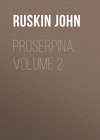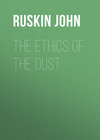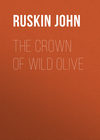Buch lesen: «Proserpina, Volume 2»
CHAPTER I
VIOLA
1. Although I have not been able in the preceding volume to complete, in any wise as I desired, the account of the several parts and actions of plants in general, I will not delay any longer our entrance on the examination of particular kinds, though here and there I must interrupt such special study by recurring to general principles, or points of wider interest. But the scope of such larger inquiry will be best seen, and the use of it best felt, by entering now on specific study.
I begin with the Violet, because the arrangement of the group to which it belongs—Cytherides—is more arbitrary than that of the rest, and calls for some immediate explanation.
2. I fear that my readers may expect me to write something very pretty for them about violets: but my time for writing prettily is long past; and it requires some watching over myself, I find, to keep me even from writing querulously. For while, the older I grow, very thankfully I recognize more and more the number of pleasures granted to human eyes in this fair world, I recognize also an increasing sensitiveness in my temper to anything that interferes with them; and a grievous readiness to find fault—always of course submissively, but very articulately—with whatever Nature seems to me not to have managed to the best of her power;—as, for extreme instance, her late arrangements of frost this spring, destroying all the beauty of the wood sorrels; nor am I less inclined, looking to her as the greatest of sculptors and painters, to ask, every time I see a narcissus, why it should be wrapped up in brown paper; and every time I see a violet, what it wants with a spur?
3. What any flower wants with a spur, is indeed the simplest and hitherto to me unanswerablest form of the question; nevertheless, when blossoms grow in spires, and are crowded together, and have to grow partly downwards, in order to win their share of light and breeze, one can see some reason for the effort of the petals to expand upwards and backwards also. But that a violet, who has her little stalk to herself, and might grow straight up, if she pleased, should be pleased to do nothing of the sort, but quite gratuitously bend her stalk down at the top, and fasten herself to it by her waist, as it were,—this is so much more like a girl of the period's fancy than a violet's, that I never gather one separately but with renewed astonishment at it.
4. One reason indeed there is, which I never thought of until this moment! a piece of stupidity which I can only pardon myself in, because, as it has chanced, I have studied violets most in gardens, not in their wild haunts,—partly thinking their Athenian honour was as a garden flower; and partly being always fed away from them, among the hills, by flowers which I could see nowhere else. With all excuse I can furbish up, however, it is shameful that the truth of the matter never struck me before, or at least this bit of the truth—as follows.
5. The Greeks, and Milton, alike speak of violets as growing in meadows (or dales). But the Greeks did so because they could not fancy any delight except in meadows; and Milton, because he wanted a rhyme to nightingale—and, after all, was London bred. But Viola's beloved knew where violets grew in Illyria,—and grow everywhere else also, when they can,—on a bank, facing the south.
Just as distinctly as the daisy and buttercup are meadow flowers, the violet is a bank flower, and would fain grow always on a steep slope, towards the sun. And it is so poised on its stem that it shows, when growing on a slope, the full space and opening of its flower,—not at all, in any strain of modesty, hiding itself, though it may easily be, by grass or mossy stone, 'half hidden,'—but, to the full, showing itself, and intending to be lovely and luminous, as fragrant, to the uttermost of its soft power.
Nor merely in its oblique setting on the stalk, but in the reversion of its two upper petals, the flower shows this purpose of being fully seen. (For a flower that does hide itself, take a lily of the valley, or the bell of a grape hyacinth, or a cyclamen.) But respecting this matter of petal-reversion, we must now farther state two or three general principles.
6. A perfect or pure flower, as a rose, oxalis, or campanula, is always composed of an unbroken whorl, or corolla, in the form of a disk, cup, bell, or, if it draw together again at the lips, a narrow-necked vase. This cup, bell, or vase, is divided into similar petals, (or segments, which are petals carefully joined,) varying in number from three to eight, and enclosed by a calyx whose sepals are symmetrical also.
An imperfect, or, as I am inclined rather to call it, an 'injured' flower, is one in which some of the petals have inferior office and position, and are either degraded, for the benefit of others, or expanded and honoured at the cost of others.
Of this process, the first and simplest condition is the reversal of the upper petals and elongation of the lower ones, in blossoms set on the side of a clustered stalk. When the change is simply and directly dependent on their position in the cluster, as in Aurora Regina,1 modifying every bell just in proportion as it declines from the perfected central one, some of the loveliest groups of form are produced which can be seen in any inferior organism: but when the irregularity becomes fixed, and the flower is always to the same extent distorted, whatever its position in the cluster, the plant is to be rightly thought of as reduced to a lower rank in creation.
7. It is to be observed, also, that these inferior forms of flower have always the appearance of being produced by some kind of mischief—blight, bite, or ill-breeding; they never suggest the idea of improving themselves, now, into anything better; one is only afraid of their tearing or puffing themselves into something worse. Nay, even the quite natural and simple conditions of inferior vegetable do not in the least suggest, to the unbitten or unblighted human intellect, the notion of development into anything other than their like: one does not expect a mushroom to translate itself into a pineapple, nor a betony to moralize itself into a lily, nor a snapdragon to soften himself into a lilac.
8. It is very possible, indeed, that the recent phrenzy for the investigation of digestive and reproductive operations in plants may by this time have furnished the microscopic malice of botanists with providentially disgusting reasons, or demoniacally nasty necessities, for every possible spur, spike, jag, sting, rent, blotch, flaw, freckle, filth, or venom, which can be detected in the construction, or distilled from the dissolution, of vegetable organism. But with these obscene processes and prurient apparitions the gentle and happy scholar of flowers has nothing whatever to do. I am amazed and saddened, more than I can care to say, by finding how much that is abominable may be discovered by an ill-taught curiosity, in the purest things that earth is allowed to produce for us;—perhaps if we were less reprobate in our own ways, the grass which is our type might conduct itself better, even though it has no hope but of being cast into the oven; in the meantime, healthy human eyes and thoughts are to be set on the lovely laws of its growth and habitation, and not on the mean mysteries of its birth.
9. I relieve, therefore, our presently inquiring souls from any farther care as to the reason for a violet's spur,—or for the extremely ugly arrangements of its stamens and style, invisible unless by vexatious and vicious peeping. You are to think of a violet only in its green leaves, and purple or golden petals;—you are to know the varieties of form in both, proper to common species; and in what kind of places they all most fondly live, and most deeply glow.
"And the recreation of the minde which is taken heereby cannot be but verie good and honest, for they admonish and stir up a man to that which is comely and honest. For flowers, through their beautie, varietie of colour, and exquisite forme, do bring to a liberall and gentle manly minde the remembrance of honestie, comeliness, and all kinds of vertues. For it would be an unseemely and filthie thing, as a certain wise man saith, for him that doth looke upon and handle faire and beautiful things, and who frequenteth and is conversant in faire and beautiful places, to have his mind not faire, but filthie and deformed."
10. Thus Gerarde, in the close of his introductory notice of the violet,—speaking of things, (honesty, comeliness, and the like,) scarcely now recognized as desirable in the realm of England; but having previously observed that violets are useful for the making of garlands for the head, and posies to smell to;—in which last function I observe they are still pleasing to the British public: and I found the children here, only the other day, munching a confection of candied violet leaves. What pleasure the flower can still give us, uncandied, and unbound, but in its own place and life, I will try to trace through some of its constant laws.
11. And first, let us be clear that the native colour of the violet is violet; and that the white and yellow kinds, though pretty in their place and way, are not to be thought of in generally meditating the flower's quality or power. A white violet is to black ones what a black man is to white ones; and the yellow varieties are, I believe, properly pansies, and belong also to wild districts for the most part; but the true violet, which I have just now called 'black,' with Gerarde, "the blacke or purple violet, hath a great prerogative above others," and all the nobler species of the pansy itself are of full purple, inclining, however, in the ordinary wild violet to blue. In the 'Laws of Fésole,' chap, vii., §§ 20, 21, I have made this dark pansy the representative of purple pure; the viola odorata, of the link between that full purple and blue; and the heath-blossom of the link between that full purple and red. The reader will do well, as much as may be possible to him, to associate his study of botany, as indeed all other studies of visible things, with that of painting: but he must remember that he cannot know what violet colour really is, unless he watch the flower in its early growth. It becomes dim in age, and dark when it is gathered—at least, when it is tied in bunches;—but I am under the impression that the colour actually deadens also,—at all events, no other single flower of the same quiet colour lights up the ground near it as a violet will. The bright hounds-tongue looks merely like a spot of bright paint; but a young violet glows like painted glass.
12. Which, when you have once well noticed, the two lines of Milton and Shakspeare which seem opposed, will both become clear to you. The said lines are dragged from hand to hand along their pages of pilfered quotations by the hack botanists,—who probably never saw them, nor anything else, in Shakspeare or Milton in their lives,—till even in reading them where they rightly come, you can scarcely recover their fresh meaning: but none of the botanists ever think of asking why Perdita calls the violet 'dim,' and Milton 'glowing.'
Perdita, indeed, calls it dim, at that moment, in thinking of her own love, and the hidden passion of it, unspeakable; nor is Milton without some purpose of using it as an emblem of love, mourning,—but, in both cases, the subdued and quiet hue of the flower as an actual tint of colour, and the strange force and life of it as a part of light, are felt to their uttermost.
And observe, also, that both, of the poets contrast the violet, in its softness, with the intense marking of the pansy. Milton makes the opposition directly–
"the pansy, freaked with jet,
The glowing violet."
Shakspeare shows yet stronger sense of the difference, in the "purple with Love's wound" of the pansy, while the violet is sweet with Love's hidden life, and sweeter than the lids of Juno's eyes.
Whereupon, we may perhaps consider with ourselves a little, what the difference is between a violet and a pansy?
13. Is, I say, and was, and is to come,—in spite of florists, who try to make pansies round, instead of pentagonal; and of the wise classifying people, who say that violets and pansies are the same thing—and that neither of them are of much interest! As, for instance, Dr. Lindley in his 'Ladies' Botany.'
"Violets—sweet Violets, and Pansies, or Heartsease, represent a small family, with the structure of which you should be familiar; more, however, for the sake of its singularity than for its extent or importance, for the family is a very small one, and there are but few species belonging to it in which much interest is taken. As the parts of the Heartsease are larger than those of the Violet, let us select the former in preference for the subject of our study." Whereupon we plunge instantly into the usual account of things with horns and tails. "The stamens are five in number—two of them, which are in front of the others, are hidden within the horn of the front petal," etc., etc., etc. (Note in passing, by the 'horn of the front' petal he means the 'spur of the bottom' one, which indeed does stand in front of the rest,—but if therefore it is to be called the front petal—which is the back one?) You may find in the next paragraph description of a "singular conformation," and the interesting conclusion that "no one has yet discovered for what purpose this singular conformation was provided." But you will not, in the entire article, find the least attempt to tell you the difference between a violet and a pansy!—except in one statement—and that false! "The sweet violet will have no rival among flowers, if we merely seek for delicate fragrance; but her sister, the heartsease, who is destitute of all sweetness, far surpasses her in rich dresses and gaudy!!! colours." The heartsease is not without sweetness. There are sweet pansies scented, and dog pansies unscented—as there are sweet violets scented, and dog violets unscented. What is the real difference?
14. I turn to another scientific gentleman—more scientific in form indeed, Mr. Grindon,—and find, for another interesting phenomenon in the violet, that it sometimes produces flowers without any petals! and in the pansy, that "the flowers turn towards the sun, and when many are open at once, present a droll appearance, looking like a number of faces all on the 'qui vive.'" But nothing of the difference between them, except something about 'stipules,' of which "it is important to observe that the leaves should be taken from the middle of the stem—those above and below being variable."
I observe, however, that Mr. Grindon has arranged his violets under the letter A, and his pansies under the letter B, and that something may be really made out of him, with an hour or two's work. I am content, however, at present, with his simplifying assurance that of violet and pansy together, "six species grow wild in Britain—or, as some believe, only four—while the analysts run the number up to fifteen."
15. Next I try Loudon's Cyclopædia, which, through all its 700 pages, is equally silent on the business; and next, Mr. Baxter's 'British Flowering Plants,' in the index of which I find neither Pansy nor Heartsease, and only the 'Calathian' Violet, (where on earth is Calathia?) which proves, on turning it up, to be a Gentian.
16. At last, I take my Figuier, (but what should I do if I only knew English?) and find this much of clue to the matter:—
"Qu'est ce que c'est que la Pensée? Cette jolie plante appartient aussi ou genre Viola, mais à un section de ce genre. En effet, dans les Pensées, les pétales supérieurs et lateraux sont dirigés en haut, l'inférieur seul est dirigé en bas: et de plus, le stigmate est urcéole, globuleux."
And farther, this general description of the whole violet tribe, which I translate, that we may have its full value:—
"The violet is a plant without a stem (tige),—(see vol. i., p. 154,)—whose height does not surpass one or two decimetres. Its leaves, radical, or carried on stolons, (vol. i., p. 158,) are sharp, or oval, crenulate, or heart-shape. Its stipules are oval-acuminate, or lanceolate. Its flowers, of sweet scent, of a dark violet or a reddish blue, are carried each on a slender peduncle, which bends down at the summit. Such is, for the botanist, the Violet, of which the poets would give assuredly another description."
17. Perhaps; or even the painters! or even an ordinary unbotanical human creature! I must set about my business, at any rate, in my own way, now, as I best can, looking first at things themselves, and then putting this and that together, out of these botanical persons, which they can't put together out of themselves. And first, I go down into my kitchen garden, where the path to the lake has a border of pansies on both sides all the way down, with clusters of narcissus behind them. And pulling up a handful of pansies by the roots, I find them "without stems," indeed, if a stem means a wooden thing; but I should say, for a low-growing flower, quiet lankily and disagreeably stalky! And, thinking over what I remember about wild pansies, I find an impression on my mind of their being rather more stalky, always, than is quite graceful; and, for all their fine flowers, having rather a weedy and littery look, and getting into places where they have no business. See, again, vol. i., chap. vi., § 5.
18. And now, going up into my flower and fruit garden, I find (June 2nd, 1881, half-past six, morning.) among the wild saxifrages, which are allowed to grow wherever they like, and the rock strawberries, and Francescas, which are coaxed to grow wherever there is a bit of rough ground for them, a bunch or two of pale pansies, or violets, I don't know well which, by the flower; but the entire company of them has a ragged, jagged, unpurpose-like look; extremely,—I should say,—demoralizing to all the little plants in their neighbourhood: and on gathering a flower, I find it is a nasty big thing, all of a feeble blue, and with two things like horns, or thorns, sticking out where its ears would be, if the pansy's frequently monkey face were underneath them. Which I find to be two of the leaves of its calyx 'out of place,' and, at all events, for their part, therefore, weedy, and insolent.
19. I perceive, farther, that this disorderly flower is lifted on a lanky, awkward, springless, and yet stiff flower-stalk; which is not round, as a flower-stalk ought to be, (vol. i., p. 155,) but obstinately square, and fluted, with projecting edges, like a pillar run thin out of an iron-foundry for a cheap railway station. I perceive also that it has set on it, just before turning down to carry the flower, two little jaggy and indefinable leaves,—their colour a little more violet than the blossom.
These, and such undeveloping leaves, wherever they occur, are called 'bracts' by botanists, a good word, from the Latin 'bractea,' meaning a piece of metal plate, so thin as to crackle. They seem always a little stiff, like bad parchment,—born to come to nothing—a sort of infinitesimal fairy-lawyer's deed. They ought to have been in my index at p. 255, under the head of leaves, and are frequent in flower structure,—never, as far as one can see, of the smallest use. They are constant, however, in the flower-stalk of the whole violet tribe.
20. I perceive, farther, that this lanky flower-stalk, bending a little in a crabbed, broken way, like an obstinate person tired, pushes itself up out of a still more stubborn, nondescript, hollow angular, dogseared gas-pipe of a stalk, with a section something like this,

but no bigger than  with a quantity of ill-made and ill-hemmed leaves on it, of no describable leaf-cloth or texture,—not cressic, (though the thing does altogether look a good deal like a quite uneatable old watercress); not salvian, for there's no look of warmth or comfort in them; not cauline, for there's no juice in them; not dryad, for there's no strength in them, nor apparent use: they seem only there, as far as I can make out, to spoil the flower, and take the good out of my garden bed. Nobody in the world could draw them, they are so mixed up together, and crumpled and hacked about, as if some ill-natured child had snipped them with blunt scissors, and an ill-natured cow chewed them a little afterwards and left them, proved for too tough or too bitter.
with a quantity of ill-made and ill-hemmed leaves on it, of no describable leaf-cloth or texture,—not cressic, (though the thing does altogether look a good deal like a quite uneatable old watercress); not salvian, for there's no look of warmth or comfort in them; not cauline, for there's no juice in them; not dryad, for there's no strength in them, nor apparent use: they seem only there, as far as I can make out, to spoil the flower, and take the good out of my garden bed. Nobody in the world could draw them, they are so mixed up together, and crumpled and hacked about, as if some ill-natured child had snipped them with blunt scissors, and an ill-natured cow chewed them a little afterwards and left them, proved for too tough or too bitter.
21. Having now sufficiently observed, it seems to me, this incongruous plant, I proceed to ask myself, over it, M. Figuier's question, 'Qu'est-ce c'est qu'un Pensée?' Is this a violet—or a pansy—or a bad imitation of both?
Whereupon I try if it has any scent: and to my much surprise, find it has a full and soft one—which I suppose is what my gardener keeps it for! According to Dr. Lindley, then, it must be a violet! But according to M. Figuier,—let me see, do its middle petals bend up, or down?
I think I'll go and ask the gardener what he calls it.
22. My gardener, on appeal to him, tells me it is the 'Viola Cornuta,' but that he does not know himself if it is violet or pansy. I take my Loudon again, and find there were fifty-three species of violets, known in his days, of which, as it chances, Cornuta is exactly the last.
'Horned violet': I said the green things were like horns!—but what is one to say of, or to do to, scientific people, who first call the spur of the violet's petal, horn, and then its calyx points, horns, and never define a 'horn' all the while!
Viola Cornuta, however, let it be; for the name does mean something, and is not false Latin. But whether violet or pansy, I must look farther to find out.
23. I take the Flora Danica, in which I at least am sure of finding whatever is done at all, done as well as honesty and care can; and look what species of violets it gives.
Nine, in the first ten volumes of it; four in their modern sequel (that I know of,—I have had no time to examine the last issues). Namely, in alphabetical order, with their present Latin, or tentative Latin, names; and in plain English, the senses intended by the hapless scientific people, in such their tentative Latin:—

I next run down this list, noting what names we can keep, and what we can't; and what aren't worth keeping, if we could: passing over the varieties, however, for the present, wholly.
(1) Arvensis. Field-violet. Good.
(2) Biflora. A good epithet, but in false Latin. It is to be our Viola aurea, golden pansy.
(3) Canina. Dog. Not pretty, but intelligible, and by common use now classical. Must stay.
(4) Hirta. Late Latin slang for hirsuta, and always used of nasty places or nasty people; it shall not stay. The species shall be our Viola Seclusa,—Monk's violet—meaning the kind of monk who leads a rough life like Elijah's, or the Baptist's, or Esau's—in another kind. This violet is one of the loveliest that grows.
(5) Mirabilis. Stays so; marvellous enough, truly: not more so than all violets; but I am very glad to hear of scientific people capable of admiring anything.
(6) Montana. Stays so.
(7) Odorata. Not distinctive;—nearly classical, however. It is to be our Viola Regina, else I should not have altered it.
(8) Palustris. Stays so.
(9) Tricolor. True, but intolerable. The flower is the queen of the true pansies: to be our Viola Psyche.
(10) Elatior. Only a variety of our already accepted Cornuta.
(11) The last is, I believe, also only a variety of Palustris. Its leaves, I am informed in the text, are either "pubescent-reticulate-venose-subreniform," or "lato-cordate-repando-crenate;" and its stipules are "ovate-acuminate-fimbrio-denticulate." I do not wish to pursue the inquiry farther.
24. These ten species will include, noting here and there a local variety, all the forms which are familiar to us in Northern Europe, except only two;—these, as it singularly chances, being the Viola Alpium, noblest of all the wild pansies in the world, so far as I have seen or heard of them,—of which, consequently, I find no picture, nor notice, in any botanical work whatsoever; and the other, the rock-violet of our own Yorkshire hills.
We have therefore, ourselves, finally then, twelve following species to study. I give them now all in their accepted names and proper order,—the reasons for occasional difference between the Latin and English name will be presently given.

25. We will try, presently, what is to be found out of useful, or pretty, concerning all these twelve violets; but must first find out how we are to know which are violets indeed, and which, pansies.
Yesterday, after finishing my list, I went out again to examine Viola Cornuta a little closer, and pulled up a full grip of it by the roots, and put it in water in a wash-hand basin, which it filled like a truss of green hay.
Pulling out two or three separate plants, I find each to consist mainly of a jointed stalk of a kind I have not yet described,—roughly, some two feet long altogether; (accurately, one 1 ft. 10½ in.; another, 1 ft. 10 in.; another, 1 ft. 9 in.—but all these measures taken without straightening, and therefore about an inch short of the truth), and divided into seven or eight lengths by clumsy joints where the mangled leafage is knotted on it; but broken a little out of the way at each joint, like a rheumatic elbow that won't come straight, or bend farther; and—which is the most curious point of all in it—it is thickest in the middle, like a viper, and gets quite thin to the root and thin towards the flower; also the lengths between the joints are longest in the middle: here I give them in inches, from the root upwards, in a stalk taken at random.

But the thickness of the joints and length of terminal flower stalk bring the total to two feet and about an inch over. I dare not pull it straight, or should break it, but it overlaps my two-foot rule considerably, and there are two inches besides of root, which are merely underground stem, very thin and wretched, as the rest of it is merely root above ground, very thick and bloated. (I begin actually to be a little awed at it, as I should be by a green snake—only the snake would be prettier.) The flowers also, I perceive, have not their two horns regularly set in, but the five spiky calyx-ends stick out between the petals—sometimes three, sometimes four, it may be all five up and down—and produce variously fanged or forked effects, feebly ophidian or diabolic. On the whole, a plant entirely mismanaging itself,—reprehensible and awkward, with taints of worse than awkwardness; and clearly, no true 'species,' but only a link.2 And it really is, as you will find presently, a link in two directions; it is half violet, half pansy, a 'cur' among the Dogs, and a thoughtless thing among the thoughtful. And being so, it is also a link between the entire violet tribe and the Runners—pease, strawberries, and the like, whose glory is in their speed; but a violet has no business whatever to run anywhere, being appointed to stay where it was born, in extremely contented (if not secluded) places. "Half-hidden from the eye?"—no; but desiring attention, or extension, or corpulence, or connection with anybody else's family, still less.

FIG. II.
26. And if, at the time you read this, you can run out and gather a true violet, and its leaf, you will find that the flower grows from the very ground, out of a cluster of heart-shaped leaves, becoming here a little rounder, there a little sharper, but on the whole heart-shaped, and that is the proper and essential form of the violet leaf. You will find also that the flower has five petals; and being held down by the bent stalk, two of them bend back and up, as if resisting it; two expand at the sides; and one, the principal, grows downwards, with its attached spur behind. So that the front view of the flower must be some modification of this typical arrangement, Fig. M, (for middle form). Now the statement above quoted from Figuier, § 16, means, if he had been able to express himself, that the two lateral petals in the violet are directed downwards, Fig. II. A, and in the pansy upwards, Fig. II. C. And that, in the main, is true, and to be fixed well and clearly in your mind. But in the real orders, one flower passes into the other through all kinds of intermediate positions of petal, and the plurality of species are of the middle type. Fig. II. B.3
27. Next, if you will gather a real pansy leaf, you will find it—not heart-shape in the least, but sharp oval or spear-shape, with two deep cloven lateral flakes at its springing from the stalk, which, in ordinary aspect, give the plant the haggled and draggled look I have been vilifying it for. These, and such as these, "leaflets at the base of other leaves" (Balfour's Glossary), are called by botanists 'stipules.' I have not allowed the word yet, and am doubtful of allowing it, because it entirely confuses the student's sense of the Latin 'stipula' (see above, vol. i., chap. viii., § 27) doubly and trebly important in its connection with 'stipulor,' not noticed in that paragraph, but readable in your large Johnson; we shall have more to say of it when we come to 'straw' itself.
28. In the meantime, one may think of these things as stipulations for leaves, not fulfilled, or 'stumps' or 'sumphs' of leaves! But I think I can do better for them. We have already got the idea of crested leaves, (see vol. i., plate); now, on each side of a knight's crest, from earliest Etruscan times down to those of the Scalas, the fashion of armour held, among the nations who wished to make themselves terrible in aspect, of putting cut plates or 'bracts' of metal, like dragons' wings, on each side of the crest. I believe the custom never became Norman or English; it is essentially Greek, Etruscan, or Italian,—the Norman and Dane always wearing a practical cone (see the coins of Canute), and the Frank or English knights the severely plain beavered helmet; the Black Prince's at Canterbury, and Henry V.'s at Westminster, are kept hitherto by the great fates for us to see. But the Southern knights constantly wore these lateral dragon's wings; and if I can find their special name, it may perhaps be substituted with advantage for 'stipule'; but I have not wit enough by me just now to invent a term.



















![Stones of Venice [introductions]](https://cdn.litres.ru/pub/c/cover_100/34843654.jpg)
